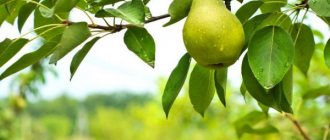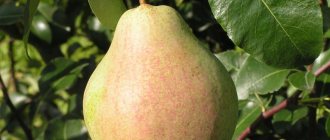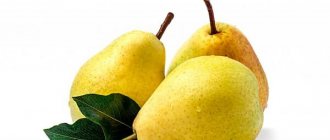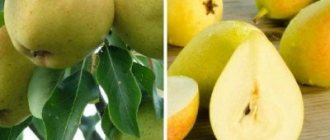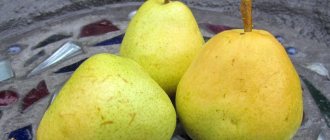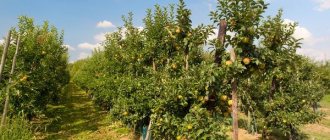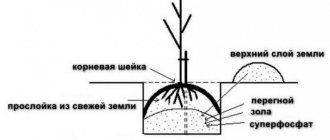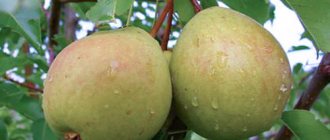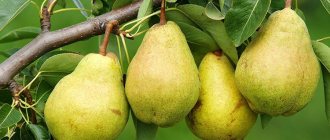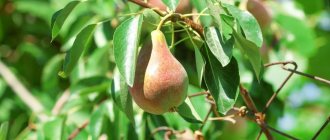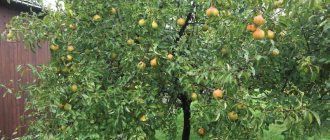The cultivation area of the Lada pear is extensive: it grows well in central Russia and Siberia. The variety is readily grown due to its many positive economic characteristics and good quality of marketable products. Valuable properties, especially for consumers in difficult climatic conditions, are the early ripening of fruits and winter hardiness of the tree.
- 2 Description and characteristics of the Lada pear
2.1 Video: review of the Lada pear variety
- 4.1 Landing
4.2.1 Photo gallery: types of crown formation
Description and characteristics of the Lada pear variety
Lada is a favorite variety of many gardeners
The parent varieties of Lada are Forest Beauty and Olga. The plant is of medium height, reaches 3 m. The crown changes as the pear develops. Until 3–4 years, it has a funnel shape. When an adult tree begins to bear fruit, the crown resembles a cone or pyramid. The bark is dark gray on the trunk and gray on the skeletal branches.
The shoots are elongated and of medium thickness, slightly curved, round in cross-section, brown in color. The buds are cone-shaped and dark in color. The leaves are green, oval-shaped, medium in size. The surface of the plate is smooth. The leaves are serrated at the edges. The length of the petioles is average. The flowers are cup-shaped, the corolla is white. The edges of the petals are entire. The color of the buds is also white. The inflorescences are racemose, corymbose, each containing 5–6 flowers.
The fruits are obovate, weigh 100–120 g, and are covered with thin skin. Their color is pale yellow. You can also notice a faint reddish blush on the fruits. The fruits have subcutaneous points, but they are not very noticeable. The stalks are short and there is no funnel. The saucer is small, tuberous, narrow in shape. Open cup. The seeds are brown, there are up to 5 of them in each fruit.
The pulp has a fine-grained and not very dense structure, yellow-white color. The taste of the fruit is sweet, with a slight presence of acid, the aroma is not pronounced. On a five-point scale, fruits are rated 4.1–4.4 points. They contain:
- 15.7% dry matter;
- 7.2% sugars;
- 12.2% soluble elements;
- 0.27% titratable acids;
- 92 mg/100 g P-active elements.
The main difference between Lada and other varieties, in particular from Chizhovskaya, is the ripening period - the variety is considered an early summer one.
Advantages and disadvantages
The Lada pear variety is distinguished by productivity and winter hardiness
The Lada pear variety is valued by gardeners for such features as:
- excellent fruiting;
- good winter hardiness;
- precociousness;
- resistance to scab and fire blight.
However, gardeners need to take into account the following disadvantages of the crop:
- low transportability;
- short shelf life of fruits;
- susceptibility to drought.
Reviews from gardeners
The Lada pear has gained considerable popularity among gardeners, so you can find many reviews about this variety on the Internet. Here are a few sayings.
Lada, like Chizhovskaya, has weak self-fertility (without another variety it will bear fruit, but it will be weak). Any variety is suitable as a pollinator; all bloom almost simultaneously.
Toliam1 https://dacha.wcb.ru/index.php?showtopic=49422&st=0&
The pear tastes good, but if you leave it on the tree for a few days, it tastes like potatoes.
Anona, https://forum.vinograd.info/showthread.php?t=9965
We planted Lada 8 years ago. Abundant fruiting began only last year. There were a lot of pears; the fruits, however, were small, but very sweet and aromatic. The only trouble was the wasps; there were so many of them that it was almost impossible to approach the tree. I had to collect it late in the evening.
Olga_D https://www.divosad.ru/forum/9-39-1
There are those who believe that Lada produces a good harvest even in the absence of neighboring pollinators, as well as those who note the excellent early fruiting of the variety. In general, from numerous reviews we can conclude that Lada is really suitable for growing in garden plots, being one of the popular varieties. From the opinions of experienced gardeners, you can learn some of the features of its cultivation and avoid problems associated with harvesting, storing fruits and other aspects.
Lada pear has become a popular variety during its short history of existence due to its qualities. First of all, this is due to its productivity and ease of care. Try planting Lada on your site and maybe she will become your favorite.
- Author: Evgeny Udaltsov
I love nature and the beauty of the world around me, I highlight this in my articles and try to help bring beauty to life. Rate this article:
- 5
- 4
- 3
- 2
- 1
(2 votes, average: 3 out of 5)
Share with your friends!
Landing Features
Lada is planted according to a typical pattern for a pear
The site for planting Lada should be on the southeast or south side. Exposure to winds is undesirable for pear trees. Therefore, you should choose a place that will be protected from drafts by buildings or other plants.
Important! Pear Lada prefers loamy soils with a neutral acidity level. Groundwater should be located at a distance of 2 m from the ground surface.
You can plant pears in the spring (April) or in the fall - before frost sets in. The most suitable period is the end of September, since in October the temperature is still quite warm, and the root system of the plant will have time to strengthen before the cold weather.
Preparing the site begins in advance. Why do the following:
- If planting is planned in the spring, then in the fall they dig a hole measuring 80 cm in depth and 1.3 m in diameter.
- The resulting soil is mixed with 700 g of dolomite, 600 g of ash, 10 kg of manure or compost and 200 g of azofoska.
- Then the mixture is poured into the recess.
When planting in autumn, the land also needs preliminary preparation; the best time for this is August. On the selected area, you need to evenly sprinkle 25 g of potassium salt, 50 g of superphosphate and 7 kg of compost (the indicated amount of fertilizer is used per 1 m²), and then dig up the soil to the level of the spade bayonet.
Lada is planted in autumn or spring
The planting process itself has the following features:
- Gardeners use a 1–2 year old seedling with 7–8 developed branches, which will subsequently become the basis for the formation of the tree crown. The plant should not have mechanical damage or dried roots.
- Then they dig a hole 70 cm deep and 1 m wide in a previously prepared area. The bottom needs to be loosened and 10 raw eggs added, which will provide the pear with the necessary nutrition in the first year.
- A stake is placed in the middle of the hole; it should exceed the soil level by 50–70 cm.
- Then the seedling is placed in the hole, straightening the roots. And sprinkle the plant with soil.
- The root collar should be placed 5–6 cm above ground level.
- Then compact the soil and water the seedling with 30 liters of water.
- The tree trunk circle is mulched with a layer of humus or manure 10 cm thick.
Lada pear is a partially self-fertile crop - it is capable of producing crops without pollinators. But their presence will improve the ovaries and increase the number of fruits.
Important! Varieties such as Pamyat Zhegalova, Otradnenskaya, Kosmicheskaya, Moskvichka, Chizhovskaya, Skorospelka, Severyanka and Rogneda are used as pollinators for Lada.
How to plant a pear - video
Dates of ripening and harvesting of fruits
The Lada variety is considered early-fruiting. Pears ripen early. If all care technologies are followed, the first harvest will appear approximately 3 years after planting the seedling. The first harvest can be harvested in early August. The main harvest can be harvested in the second half of August. Approximately one tree can ripen up to 50 kg of pears.
The fruits on the fruit stalk are held tightly. Pears may begin to drop as soon as they are fully ripe. This advantage will allow you to harvest in mid-September. By this time, the pears will become amber-golden with a blush.
Preserving pear fruits is not difficult. You will need a dark, well-ventilated room, the temperature should be approximately 1–4 °C. Optimal air humidity is at least 85%. Fruits should be stored in plastic containers or wooden boxes. The fruits should be laid in layers, which should be separated by clean paper.
Advice! There is no need to do more than two layers in one box.
Often the fruits are stored in sand. When laying pears, the layers can be sprinkled with sand. Using this trick, the storage of pears will last until November.
Plant care
Watering
Lada needs plenty of watering
Lada can hardly tolerate drought, so special attention should be paid to watering it. A young tree up to 3–4 years old is moistened as the soil dries. The regularity of watering depends on weather conditions and the condition of the plant itself. You can moisten the pear once a week at this time. For 1 m² of tree trunk area you will need 20 liters of water.
When the tree reaches the fruiting period, it is watered 2 times during the growing season:
- before flowering begins;
- after this stage.
This procedure can be performed in two ways:
- Sprinkling. Watering is carried out using rotating sprayers that spray drops of water.
- Using grooves. A hole 20 cm deep is dug around the tree and water is supplied into it.
Fertilizers
From the second year after planting, the pear needs to be fed. Young trees under 3 years of age are fertilized only within the trunk circle (within a radius of 1.5 m). After the start of fruiting, fertilizing is also applied between the rows.
The scheme is as follows:
- for one tree aged from 4 to 12 years, 4 g/m² of phosphorus and 6 g/m² of potassium are required;
- for pears aged 12–20 years, phosphorus consumption should be 6 g/m², potassium 8 g/m²;
- the norm for plants over 20 years old is 8 g/m² phosphorus and 12 g/m² potassium.
Fertilizers are applied in the spring - before flowering, and also in the fall - before frost, when loosening the soil in the tree trunk circle. The soil is dug up to 10–12 cm.
Trimming
Scheme for correct pear crown molding
Pruning will help shape the crown and ensure uniform lighting of the tree. The procedure is carried out in the spring - before the buds open (in March), or in the autumn - before frost (in October). The first pruning is performed immediately after planting. Shorten the central shoot by ¼ length. Then select the 4 most developed branches and cut them 20 cm below this level.
Next year, shorten the central conductor by 20–25 cm. Cut the branches by 5–7 cm. The upper shoots should be made shorter, and the lower shoots, which extend at an obtuse angle, should be made longer. Pruning in subsequent years consists of removing overgrowth and damaged branches, as well as thinning the crown.
Important! Treat sections whose diameter exceeds 1.5 cm with garden varnish (250 g of grease, 200 g of wax and 50 g of resin).
Spring pruning of pears - video
Whitewashing and mulching
Whitewashing a pear will protect the tree from pests
Before the onset of winter, the trunk and skeletal branches need to be whitened - this will help protect the tree from rodents. To prepare the solution, you need to dilute 0.5 liters of copper sulfate and 2.5 kg of lime in 10 liters of water. For the procedure, use a paint brush.
Mulching the soil in the area around the trunk will help protect the root system from freezing. Grass or sawdust is suitable for this purpose. The mulch is laid in a layer of 15–20 cm. Young trees up to 4 years old are wrapped in paper or spruce branches for the winter.
Cultivation
The described culture is characterized by easy survival. It is grown both in the recommended regions and in central Russia, ideal for the Moscow region. To grow a healthy tree, you need to work hard, choosing a suitable site and planting it correctly.
Landing dates
The main activities for planting seedlings are carried out in early spring before the movement of plant juices begins. In the Black Earth Region, these dates can be shifted to the beginning of autumn. When planted in early autumn, the seedling will have every chance of successful rooting and an easy first winter.
Selection of seedlings
Planting a pear is preceded by the purchase of a seedling. Successful cultivation and crop yield largely depend on the quality of planting material.
Experienced gardeners recommend purchasing seedlings only from local nurseries. Such a tree itself adapts to the characteristics of the cultivation region.
Pay special attention to the root system. If you purchase material in a container, make sure that the earthen ball is dense and well moistened. A healthy root system is elastic; in addition to 3-4 powerful roots, there is a network of small roots. Gently pull the base of the plant; if it comes out of the container along with a lump of earth, the seedling will quickly take root in its new place.
External inspection should not reveal any traces of damage to shoots or damage by pests. Two-year-old layerings take root better and exhibit good winter hardiness.
Selection and preparation of a site for a pear
To provide decent conditions for the growth of a heat-loving crop in an alien climate, rely on natural habitat conditions.
- It is preferable to choose bright, open areas for cultivating crops. The southern or south-eastern parts of the garden are ideal for planting.
- Pear cultivation is carried out in a place where cold winds do not blow in winter and a lot of snow accumulates for shelter.
- Lighting of the area - at least 10 hours a day. The young seedling will need temporary shading during the midday hours, otherwise the foliage will wither and wither.
- When selecting a site, make sure that there are suitable pollinators nearby.
- groundwater at the selected location should not be in close proximity to the surface. Minimum level 2-2.5 m.
Regarding the choice of soil, the cultivar is very unpretentious. Loose substrates rich in humus are suitable - chernozem, light loam, gray forest soil. Only clay is not suitable for planting, because it interferes with root respiration and contributes to moisture stagnation.
If the soil in which you are planning to plant a tree does not meet the requirements, improve it. To loosen, use sand and peat to increase fertility - humus or compost.
Landing technology
To properly plant a seedling, follow the following instructions:
- For spring planting, prepare the hole in the fall. If this is not possible, the pit is prepared 2-3 weeks before work;
- hole depth 70-100 cm, diameter 0.8-1 m;
- Mix the excavated soil with 2-3 buckets of compost or humus. Add 200 g of azofoska, half a kilo of ash, 700 g of dolomite flour;
- Pour the resulting nutrient soil mixture into the hole in the form of a slide. If necessary, first build a drainage layer of crushed stone or brick chips 15 cm high;
- before planting a tree, install a support stake 30 cm from the center of the hole;
- place seedlings with an open root system in a bucket of water for 2-3 hours;
- spread the roots evenly over the surface of the shaft. Add the substrate, shaking the plant periodically so that there are no voids, compact the soil;
- form a circle around the trunk, pour out 2-3 buckets of water. After complete absorption of the liquid, mulch the space with a ten-centimeter layer of humus.
Make sure that the root collar is not buried. This part of the seedling should protrude 4-7 cm above the ground surface.
You can clearly see the planting process in this video.
Diseases and pests
The Lada variety is resistant to scab and fire blight. But may be exposed to other diseases.
Diseases characteristic of the variety and methods of treatment - table
| Diseases | Symptoms | Fighting methods |
| Powdery mildew |
|
|
| Fruit rot |
|
|
| Rust | The appearance of red or orange swellings on the outside of the leaves, reminiscent of rust. |
|
| Cytosporosis |
|
|
| Bark cracking | The appearance of cracks in the bark. | Whitewashing in November with a solution of 1 kg of lime, 4 kg of clay, 3 kg of mullein, 2 tbsp. l. copper sulfate, 40 g of soap, 6 ml of Epin, 2 tbsp. l. office glue and 10 liters of water. |
Typical diseases of the Lada pear in the photo
Cytosporosis is a fungal disease that causes drying of the bark
Rust is a fungal disease that affects leaves.
Cracking of the bark develops as a result of a sharp drop in temperature
Fruit rot is a disease caused by fungal spores.
Powdery mildew develops in moist environments
Crop pests and control measures - table
| Pests | Signs | Ways to fight |
| Slimy sawfly |
| Spraying after picking fruits with a solution of karbofos or chlorophos (20 g per 10 l of water) or soda ash (50 g of soda, 40 g of soap per 10 l of water, consumption 3 - 4 l). |
| Pear mite | Formation of swellings on the leaves, premature falling off. | Spraying with a solution of colloidal sulfur (100 g per 10 l of water, consumption 3 l). |
| Ringed silkworm | Presence of oviposition on shoots. |
|
| Goldentail | The appearance on the tree of nests of 5–7 connected leaves. | Destruction of nests. Use of the drug Decis (1 g per 10 liters of water, consumption 3–4 liters). |
| hawthorn | The presence of holes in the leaves. | Treatment with Entobacterin before bud break. |
Common pests of the variety in the photo
The ringed silkworm caterpillar reaches a length of 6 cm
The mucous sawfly is a black insect that reaches a length of 4–6 mm
Goldentail is a white-colored butterfly with golden hairs at the end of its abdomen.
The pear mite has a cylindrical body, red or white.
Hawthorn - a butterfly with white wings on which there are black veins
Harvesting
Lada fruits are harvested for 2-3 years
Lada begins to bear fruit at 2–3 years of age. The variety is early ripening, the fruits ripen by mid-August. From one tree you can get about 50 kg of fruit. After ripening, the fruits do not fall off. You can use baskets, boxes or buckets for assembly. Also prepare a ladder to reach fruits from the upper branches.
You should not shake off the pears; as a result, they may suffer mechanical damage. The fruit must be grasped with all fingers and removed, holding the stalk.
Important! When picking pears, avoid damaging the fruit branches, otherwise the harvest will be smaller next year.
Lada pear can be stored for 60 days at a temperature of +1...+4 °C and a humidity of 90% in a wooden or plastic container. The harvest can be placed in the basement or cellar, and a small amount in the refrigerator.
Fruits have a low level of transportability - during transportation they lose their visual appeal. The fruits of the Lada variety are universally used. They make jam, compotes, juices, and dried fruits. Pears are also consumed fresh as an independent dessert.
History of selection and region of breeding
The variety has a recent history and owes its appearance to the Agricultural Academy, which is located in Moscow.
Employees obtained a new species by crossing two varieties “Forest Beauty” and “Olga”. The characteristics of the resulting tree exceeded expectations in terms of its performance. Since 1993, the Lada variety has been entered into the state register.
It has become widespread in the Moscow region, and is also actively grown in the Central, Volga and Central Black Earth regions.
Also in these regions, the following varieties are successfully grown: Bere Russkaya, Skorospelka from Michurinsk, Quiet Don and Orlovskaya Krasavitsa.
Pear variety “Lada”, its full characteristics and photos of the fruit are further in the article.
